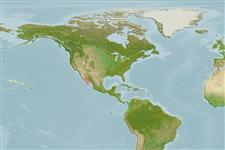>
Ophidiiformes (Cusk eels) >
Dinematichthyidae (Viviparous brotula)
Etymology: Ogilbia: Taken from Ogilby, 1887-1915, icthiologist and zoologist (Ref. 45335); nudiceps: Named for the scale-less head; 'nudi' = naked and 'ceps' = head.
Eponymy: James Douglas Ogilby (1853–1925) was an Irish-born Australian ichthyologist and taxonomist, son of the famous zoologist William Ogilby (below). [...] (Ref. 128868), visit book page.
More on authors: Møller, Schwarzhans & Nielsen.
Environment: milieu / climate zone / depth range / distribution range
Écologie
marin récifal; profondeur 0 - 30 m (Ref. 57883). Tropical; 29°N - 22°N
Eastern Pacific: Gulf of California.
Taille / Poids / Âge
Maturity: Lm ? range ? - ? cm
Max length : 5.3 cm SL mâle / non sexé; (Ref. 57883); 7.4 cm SL (female)
Description synthétique
Clés d'identification | Morphologie | Morphométrie
Rayons mous dorsaux (Total) : 63 - 72; Rayons mous anaux: 49 - 56; Vertèbres: 40 - 41. The species is characterized by having the following: Vertebrae 11 + 29-30 = 40-41, dorsal fin rays 63-72, anal fin rays 49-56; small eyes (1.4-2.6, x = 1.9 % SL); outer pseudoclasper broad wing-shaped with slightly expanded tip; inner pseudoclasper with two stout branches, anterior pointing forward, posterior straight, with fleshy lobe in between, penis with abrupt change
from thick base to thin tip; opercular spine with single, sharp tip, no scales on cheeks; otolith elongate, length: height ratio 2.4 (Ref. 57883).
Inhabits rocky and sandy bottoms. A 63 mm SL female specimen (USNM 375546) contained 160 embryos, 4-5 mm TL, with three short rows of small pigment spots posteriorly on the body. No eggs. A 55 mm SL female (SIO 65-185) contained about 600 eggs, 0.5 mm in diameter (Ref. 57883).
Life cycle and mating behavior
Maturité | Reproduction | Frai | Œufs | Fécondité | Larves
Møller, P.R., W. Schwarzhans and J.G. Nielsen, 2005. Review of the American Dinematichthyini (Teleostei: Bythitidae). Part II. Ogilbia. aqua, J. Ichthyol. Aquat. Biol. 10(4):133-207. (Ref. 57883)
Statut dans la liste rouge de l'IUCN (Ref. 130435: Version 2024-1)
Menace pour l'homme
Harmless
Utilisations par l'homme
Outils
Articles particuliers
Télécharger en XML
Sources Internet
Estimates based on models
Preferred temperature (Ref.
123201): 23 - 26.6, mean 24.3 °C (based on 56 cells).
Phylogenetic diversity index (Ref.
82804): PD
50 = 0.5000 [Uniqueness, from 0.5 = low to 2.0 = high].
Bayesian length-weight: a=0.00389 (0.00180 - 0.00842), b=3.12 (2.94 - 3.30), in cm total length, based on all LWR estimates for this body shape (Ref.
93245).
Niveau trophique (Ref.
69278): 3.3 ±0.5 se; based on size and trophs of closest relatives
Fishing Vulnerability (Ref.
59153): Low vulnerability (10 of 100).
